We can all use a lesson in humidity. From frizzy hair to warding off wrinkles, high humidity affects each of us differently. Some esteem humidity for its benefits, but humidity can cause destruction. High humidity levels impact both personal health and the health of your home. So, what is humidity exactly? How does indoor humidity play a role in home health? Are there advantages to low humidity versus high humidity levels? Learning what humidity percentage is ideal and ways to control the humidity in a crawl space or lower levels of your home will help prevent moisture problems in the future. Here we will look at some of the benefits and some of the drawbacks of high humidity, how to define and measure humidity, and what you can do to maintain a healthy, climate-controlled crawl space.
 Benefits
Benefits
Humidity boasts its benefits when it comes to personal health.
A rise in humidity:
- Reduces wrinkles
- Promotes healthier hair
- Lends smoother skin
- Reduces fatigue
- Hydrates dry, cracked skin
- Reduces snoring
- Improves vocal cords
- Aids in a productive cough
And that’s only a handful of advantages to an increase in humidity when it comes to personal health and happiness. No wonder so many enjoy the 100% humidity of a steam room, in-home humidifiers, and the emergence of Spring!
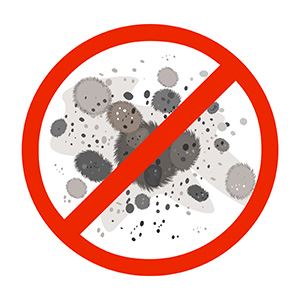 Drawbacks
Drawbacks
Humidity is not all sunshine and roses, however. In fact, it’s often quite the opposite—dark, damp, and in your crawl space where it should be unwelcomed. Too much moisture in the air fosters a too humid environment that leads to crawl space problems like:
- Mold growth
- Dust mites
- Allergens
- Condensation
- Rust
Unfortunately, your home and overall health are not in favor of the same humidity level your skin falls in love with. Excessive humidity can lead to structural damage, as mold and mildew weaken the wood they grow on. This mold and mildew can also make breathing difficult as mold spores and other allergens release into the air. Because mold, mildew, dust mites, and other pests thrive in overly moist environments, discovering these in your home most likely hints to improperly maintained levels of humidity, which can lead to aggravated allergies and other health problems if left imbalanced.
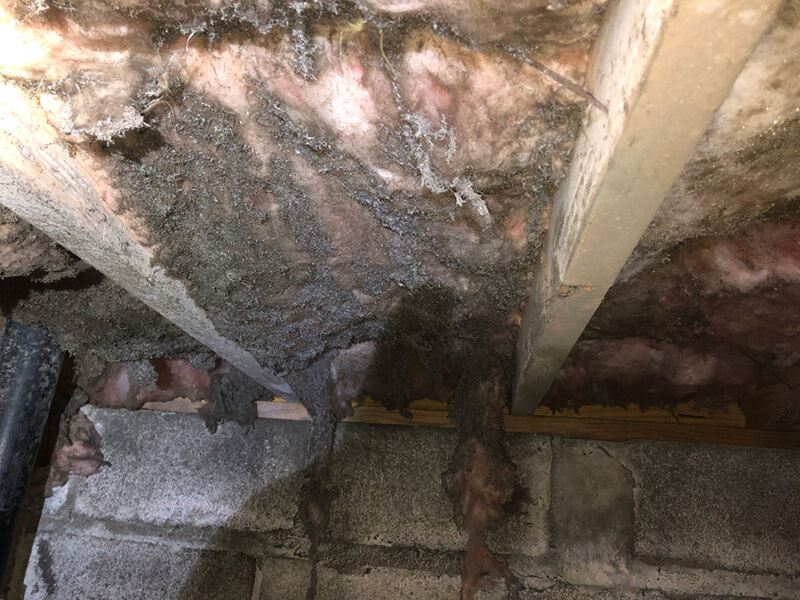
 Humidity Defined
Humidity Defined
To understand further why you should address high levels of humidity in the crawl space, let’s first look at what humidity is and how a rise in humidity happens. Humidity is what the National Weather Service says we “feel” outside and is formally referred to as absolute humidity. Absolute humidity is the measure (expressed in grams) of the amount of water vapor or moisture present in the air. When more water is present in the air, the absolute humidity is higher. Absolute humidity does not change with the temperature.
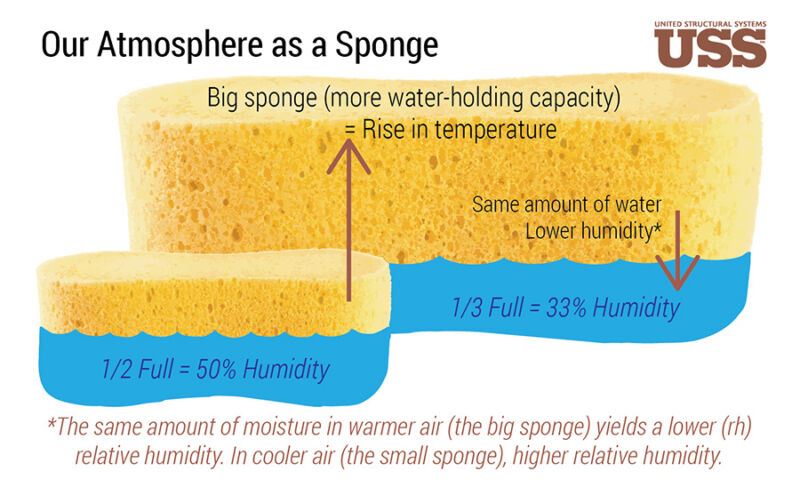
Cold air cannot hold as much water as warm air can. So, the higher the temperature, the higher the holding capacity is. When the temperature falls, with no change in the amount of water in the air, the relative humidity rises. As temperature rises, with no change in the amount of water in the air, relative humidity falls.
This article, in conjunction with the average meteorologist, refers to relative humidity—the most common measure of moisture content in the air (noted as a percentage). Relative humidity (RH) is the proportion of water vapor in the air relative to the temperature. National Geographic Encyclopedia explains that a relative humidity of 70% means the air is at 70% of its water-holding capacity. The moisture-holding capacity of the air depends on its temperature.
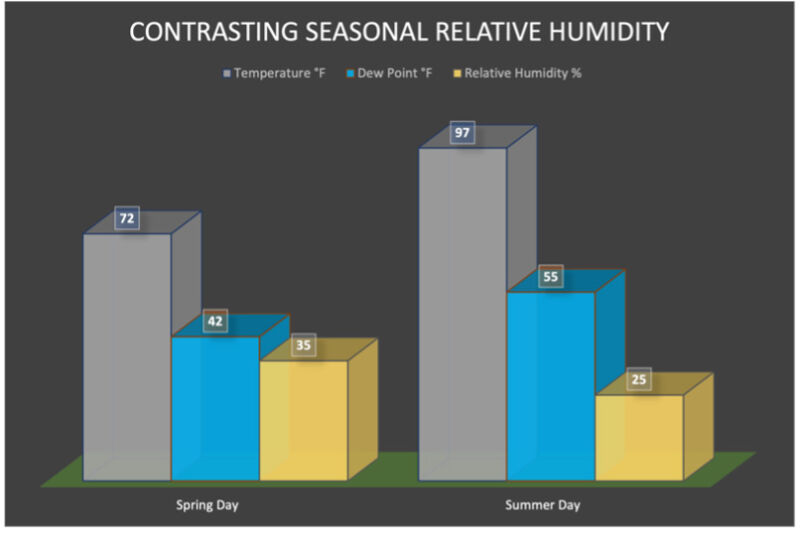 Obviously, humidity can be quite confusing. Midwest Meteorologist Brian Neudorff helps further explain, “On a hot, sticky, uncomfortable summer day, we can have an outside temperature of 97 with a dew point temperature of 55. (Dew point is the saturation point at which water will begin to liquefy out of the air.) This gives us a relative humidity of about 25 percent. On a comfortable, warm, spring day we can have an outside temperature of 72 with a dew point temperature of 42, giving us a relative humidity of about 35 percent. Although the summer day feels more humid than the spring day, its relative humidity is actually lower.” See the illustrations for further explanation.
Obviously, humidity can be quite confusing. Midwest Meteorologist Brian Neudorff helps further explain, “On a hot, sticky, uncomfortable summer day, we can have an outside temperature of 97 with a dew point temperature of 55. (Dew point is the saturation point at which water will begin to liquefy out of the air.) This gives us a relative humidity of about 25 percent. On a comfortable, warm, spring day we can have an outside temperature of 72 with a dew point temperature of 42, giving us a relative humidity of about 35 percent. Although the summer day feels more humid than the spring day, its relative humidity is actually lower.” See the illustrations for further explanation.
 Measuring Indoor Humidity
Measuring Indoor Humidity
Measuring indoor humidity can help indicate moisture problems in the crawl space or other underlying areas of your home. Homeowners may measure humidity levels using a humidity gauge or meter, such as the thermo-hydrometer which monitors both temperature and humidity in the crawl space. Indoor relative humidity (RH) levels should be kept below 60%, according to the US Environmental Protection Agency (EPA), and ideally between 30-50%, which is the best humidity level to prevent mold growth. An encapsulation expert can help you identify the cause of high humidity in the crawl space and achieve ideal humidity levels efficiently.

Note the contrast in temperatures in these three photos compared to the relative humidity (rh) readings on the digital humidity meter. Two different areas of the crawl space reflect a drop in temperature and a rise in humidity. Outside, even though the temperature is a scorching 103°, the humidity has a lower, more acceptable level of 40%. The cooler air in the crawl space has less capacity to hold the existing water vapor and therefore presents a higher humidity level needing a crawl space solution.
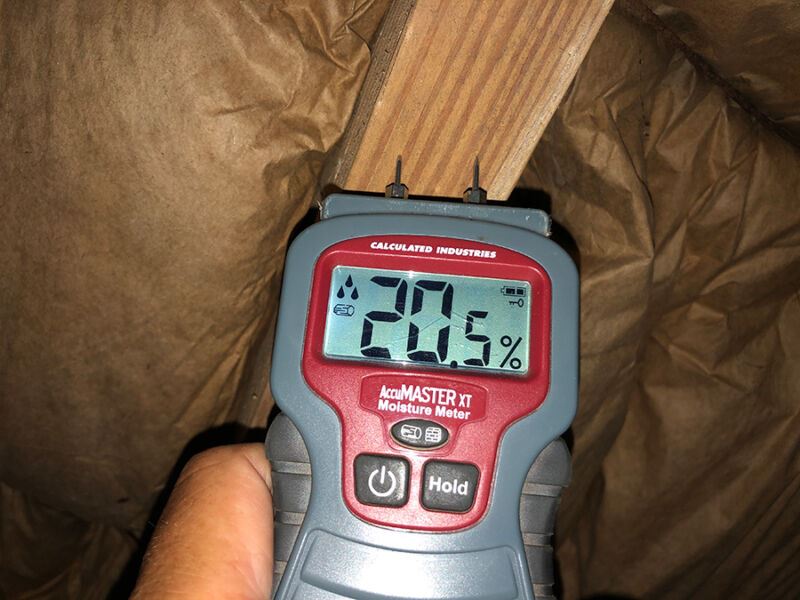 In addition to the thermo-hydrometer, an expert will utilize a protimeter, or digital wood moisture meter, to determine if the wood in your crawl space is saturated with moisture. Early detection of less visible moisture in the crawl space, such as that in wet floor joists and damp subfloor, can help deter the need for more foundation repairs. Once wood is visibly wet, the materials have already been compromised. Wood rot can start to develop as early as a 20% moisture content reading (as measured in the photo), whereas wood does not typically feel damp below 30%. Dampness causes problems long before it can be detected, so it’s important to contact a professional to measure moisture content in your crawl space if you suspect a rise in the humidity levels.
In addition to the thermo-hydrometer, an expert will utilize a protimeter, or digital wood moisture meter, to determine if the wood in your crawl space is saturated with moisture. Early detection of less visible moisture in the crawl space, such as that in wet floor joists and damp subfloor, can help deter the need for more foundation repairs. Once wood is visibly wet, the materials have already been compromised. Wood rot can start to develop as early as a 20% moisture content reading (as measured in the photo), whereas wood does not typically feel damp below 30%. Dampness causes problems long before it can be detected, so it’s important to contact a professional to measure moisture content in your crawl space if you suspect a rise in the humidity levels.
Taking moisture and humidity readings throughout the home as well as outdoors can help prove problems with high humidity. Even though these moisture detecting instruments are readily available online, consult an expert when dealing with humidity and moisture issues in your crawl space. If humidity levels remain high, contact a waterproofing and foundation repair company to best determine how to remedy your crawl space moisture problems, which could be the cause of high humidity indoors.

 Causes of High Humidity
Causes of High Humidity
Some causes of high humidity levels in the home that may be identified by an encapsulation expert or waterproofing contractor include:
- Water intrusion (from leaks, damage, improper grading)
- Rising damp or water evaporation from a dirt floor crawl space
- Leaky plumbing or faucets (warrants a call to local plumber)
- Lack of ventilation for moisture generating appliances, such as dryers
- Increase in daily activities like showering, cooking, and washing
- Climate change
Moisture, which assists in raising the humidity levels in your home, can originate from any of these sources. The amount of moisture that the air in your home can hold depends on the temperature of the air. As the temperature goes down, the air can hold less moisture. This moisture is what encourages mold growth, and mold can damage wood in your crawl space, weakening the support system of your house.
 Signs of Moisture
Signs of Moisture
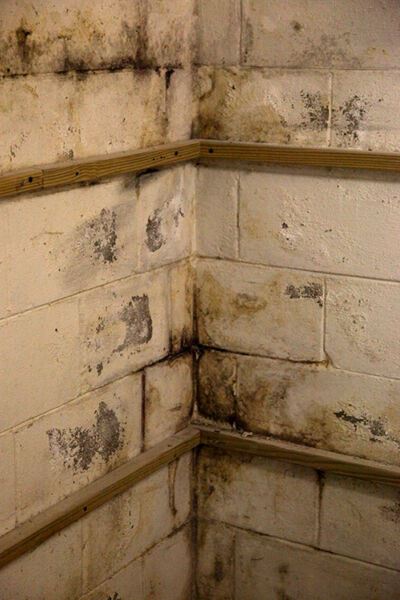 Still unsure about moisture and humidity in the crawl space? Look for these additional signs in your home that could point to a humidity problem or excessive moisture:
Still unsure about moisture and humidity in the crawl space? Look for these additional signs in your home that could point to a humidity problem or excessive moisture:
- Mineral deposits on or near floor surfaces
- HVAC duct condensation
- Peeling paint or discoloration of walls
- Creaking or buckling floors
- Wet insulation
- Mold and mildew growth
- Visible rust
If mold growth is present, reach out to a mold remediation professional to address the removal of mold and mildew. The presence of high humidity levels must be addressed to preserve the structural integrity of your home. Attacking the underlying causes of mold and mildew with a moisture expert is the only way to prevent the return of organic growth.

Your crawl space has the best clues when looking for evidence of high humidity. In addition to organic growth, you may find condensation on heating and cooling ductwork. Condensation happens when humid air meets a cold surface, such as air conditioning ductwork in a crawl space. Interior windows with condensation do not necessarily point to high humidity. But rust is an indicator of moisture or water in the crawl space. Moisture is the main catalyst for the rusting process, which can be found in damp, humid air. You may find rust on an HVAC metal trapeze, or ductwork hanger. Below the ductwork on the ground beneath it, you may also find signs of moisture. Dirty, ringed patterns on a vapor barrier reveal where water was once present and has evaporated. Condensation, rust, and water rings are signs of moisture and humidity issues in the crawl space that need attention to preserve your home.

 Solutions for High Humidity Problems
Solutions for High Humidity Problems
One of the most effective solutions that a humidity expert recommends to control humidity in the crawl space is encapsulation. Encapsulation is the ultimate defense against high humidity. A complete encapsulation may include:
- Encapsulation liner
- Drainage matting
- Dehumidifier
- Airtight crawl space door
- Spray foam, encapsulation tape, and additional sealants
Adding a dehumidifier to an encapsulated crawl space is a great way to reduce the humidity levels in your home. When paired with encapsulation, a dehumidifier in the crawl space can effectively lower humidity levels to the normal range of 30-50%.
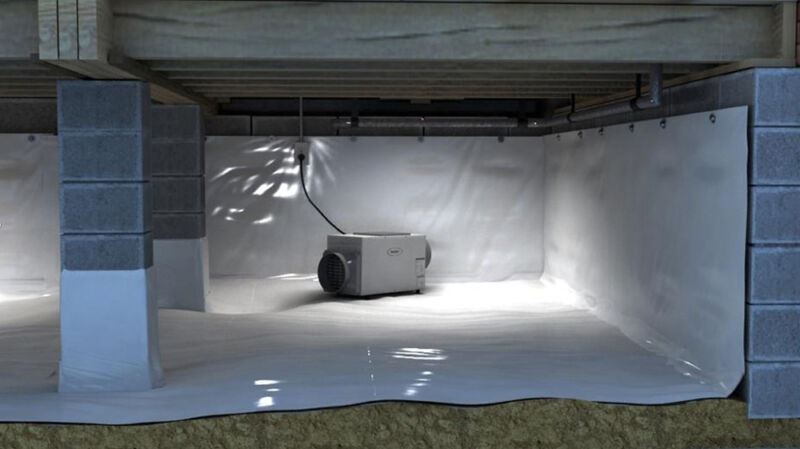
It is important to note that while encapsulation remedies moisture and humidity problems in the crawl space, encapsulation is not a waterproofing method and is not intended for basements or living areas. Discuss basement waterproofing or interior drainage solutions with a waterproofing and foundation repair contractor if water intrusion is an issue. Encapsulation assists in preventing high humidity moisture content, which in turn prevents allergens from organic growth from entering the living spaces of your home, by creating a sealed protective barrier in your crawl space. While encapsulation helps prevent mold growth, it does not remove existing mold or mildew. Contact a mold remediation company to remove existing organic growth prior to a crawl space repair or encapsulation. The cleaner the air beneath your home, the cleaner the air will be in your living areas.
Enjoy the benefits of a warmer climate’s humidity but understand that hosting that level of humidity in your home can sow disaster. Deviating from the normal indoor humidity range of 30%-50%, whether lower or higher, can affect the structural integrity of your home and possibly your personal health. If you are wondering how to remove humidity from your basement in Nashville, USS will not disappoint you! Contact us for all your humid crawl space or other moisture problem needs in your home! We provide free estimates for crawl space repair. Our team of experts in Nashville can remove moisture from your basement safely and effectively by replacing previously installed encapsulations that may not be working effectively, and we back our encapsulation service with a lifetime warranty. Call USS. We guarantee our best and we’re here to help!


